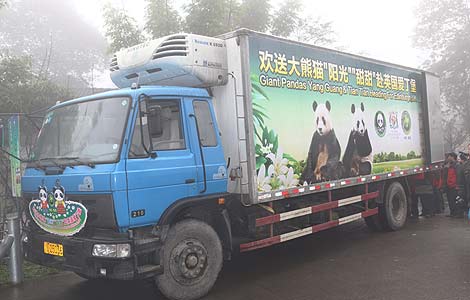China shapes global luxury landscape
Updated: 2011-12-10 16:50
(Xinhua)
|
|||||||||
BEIJING - Liang Haojie took a visiting friend to shop at a local mall in North China's Shanxi Province where he had bought a Trussardi jacket a few days ago.
Liang is a regular customer at Tianmei Mingdian Mall in Taiyuan city, a shopping center that exclusively sells luxury products from abroad. Italy's Trussardi is one of popular brands in local market.
"I've been fond of high-quality coats since I was very young. A good quality jacket priced at no more than 20,000 yuan ($3,174) is acceptable to me," said Liang, who earns over 400,000 yuan a year as a chef at a local grand hotel.
"I work hard, so I should treat myself better," he explained.
Increasingly affluent Chinese consumers like Liang are developing a strong desire for the finer things, as the nation's opening-up brings more luxury stores to their doorstep. In an environment of stagnant global growth, the nation has become a key source of growth for the world's luxury market.
"Following China's entry into the WTO (World Trade Organization), global luxury brands are jostling to expand in a country that opens wider," said Michael Ouyang, CEO of the China office with the World Luxury Association (WLA).
Ouyang said 340 luxury brands, or 85 percent of the world's total, are available in the Chinese market.
A WLA report this year predicts that China, currently the world's second largest luxury market, will overtake Japan as the largest next year, though the government said early this month that it has enormous tasks to help over 100 million people still living under the newly-set 2,300-yuan-per-year ($362) poverty line.
Only a decade ago, Chinese consumers barely understood luxuries, and those buying them only saw it a way to flaunt wealth. Now they are clients who value quality, fashion and self-image.
Zhao Yan, manager of Tianmei Mingdian's administrative department, knows exactly how this transformation has occurred. She said having a loyal consumer such as Liang was difficult when the mall first opened in 2002, a year after China joined the WTO.
Unlike sales booms in the first-tier cities such as Beijing and Shanghai, luxury goods, especially foreign brands, got a cold shoulder in the second- and third-tier cities at the very start, even in Shanxi Province, which is known for both its rich coal resources and abundance of wealth from coal mining.
"Some days, barely any customers visited the mall. Brands were reluctant to work with us," Zhao said. "It wasn't until 2005 when the business started to get better."
Over the 2005-2010 period, China's urbanization process sped up, with its economy growing at an annualized rate of 11.2 percent, well above the global average level. Its per capita GDP exceeded $4,000. During the period, Shanxi's GDP also more than doubled the previous five years'.
With more foreign firms expanding in China to accommodate the demand of increasingly wealthy buyers, the luxury industry has become one of the fastest growing sectors in the economy.
Zhao said the mall is attracting more high-end foreign brands, and so are other newly-built local malls.
Cai Sujian, president of China Luxury Institute, said rapid economic growth has made luxuries more affordable in China. Moreover, Chinese buyers are gaining a more global perspective and open attitude toward foreign cultures, especially among the urban youth born in the 1980s and 1990s.
Zhao Qing, 28, recently bought her boyfriend a 2,000-yuan Montblanc pen as a birthday and Christmas gift.
"I heard that Montblanc has been in Taiyuan for ten years. It has a good reputation," said Zhao, who earns just around 2,000 yuan a month in a government-affiliated institution in Shanxi.
Wu Tao, head of Montblanc's direct store in Taiyuan, said revenue of the German brand grew 30 percent annually on average over the past ten years.
Taiyuan's growing appetite for luxury goods has mirrored that of the country's other second- and third-tier cities, which Ouyang said fosters the greatest growth potential for luxury consumption.
According to a report jointly released by the Beijing's University of International Business and Economics (UIBE) and the Fortune Character magazine last month, luxury sales grew fastest in second-tier cities, especially in Hangzhou, Shenyang and Chengdu.
"China's rising consumption power is changing the global luxury market landscape," Cai said, noting that while luxury brands saw no growth in European markets amid the global meltdown and eurozone debt woes, China's strong purchasing power assured robust growth.
China's luxury goods saw 16-percent growth in 2009 and hit 12 billion U.S. dollars in 2010, according to the data with McKinsey & Company.
In the UIBE and Fortune Character's report, 63 percent of surveyed consumers say they will increase spending or keep level spending in the future, reflecting the nation's strong buying power despite the ongoing global financial turmoil.
Wang Qingyun, chief marketing officer of Ipso in Greater China, predicts that 29 percent of global luxury goods sales will come from China by 2015.











